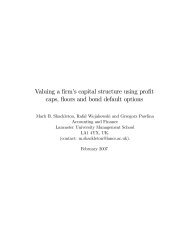Recombining Trinomial Tree for Real Option Valuation with ...
Recombining Trinomial Tree for Real Option Valuation with ...
Recombining Trinomial Tree for Real Option Valuation with ...
- No tags were found...
Create successful ePaper yourself
Turn your PDF publications into a flip-book with our unique Google optimized e-Paper software.
the expected PV of subsequent cash flows, and the actual realized PV t , calculated as therealizations of the subsequent cash flows 12 .The standard deviation in this approach is actually computed as a standard root mean square ofthe deviations between the regression estimator results and the realized simulated resultsPV t . First, we calculate the estimated expected value <strong>for</strong> from the values of X i,k generated inthat trial using the regression equation. Then, we measure the differences between valuespredicted by the regression estimator and the values actually observed from the realizedsimulations. Then we square all the deviations, add them together, divide them by the number ofmeasurements, and take the square root. Because the calculation is based on a <strong>for</strong>ecasting erroron simulation based realized values instead of true measured values, term root mean square erroris often used instead of standard deviation 13 .The challenge in this approach is in determining a good regression estimator . Usually alinear combination of the most significant cash flow calculation state variables X k,t at the presentmoment t is a good approximation <strong>for</strong> the estimator. For the first time period, this expected valueestimator can be constructed as follows: , , , , ⋯ , , (45)On the other hand, it is not necessary to use the cash flow components X k,t of a single year asexplanatory variables. Often the whole cash flow of a time period CF t may be used as anexplaining variable, so that: (46)If these models are extended to other time periods, they become:and , , ⋯ , , (47) ⋯ (48)12 This approach, similarly to Brandao et al (2005) and Godinho (2006), ensures that only the earlier years’ cashflow components are stochastic, and the expected underlying asset is conditional on the earlier outcomes of cashflow simulation.13 Standard deviation is often used to describe deviations on realized observable historical data or measurable data.Mathematically, both are practically the same.18



